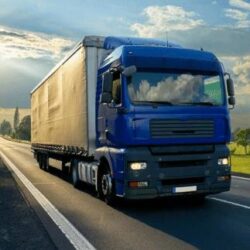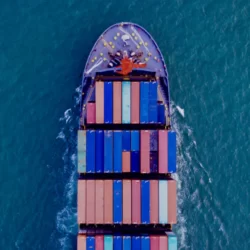Logichem 2022: How can a chemical company become climate-neutral?

Chemical companies have their work cut out if they are to meet climate targets and become fully climate-neutral by 2050. It all starts with visibility: gaining insight into which parts of the supply chain are responsible for carbon emissions and other harmful environmental effects. But that is only the beginning. What measures can a company take to completely neutralize its environmental impact? At Logichem 2022, BASF, Dow and other major chemical firms explained how they are approaching this issue.
By Harm Beerens
Visibility and sustainability were the key themes of Logichem 2022, the three-day conference for supply chain professionals in the chemical sector, which was held earlier this year at the De Doelen venue in Rotterdam. Almost all keynotes, panel discussions and breakout sessions were about providing visibility into goods flows, measuring CO2 emissions and improving the sustainability of supply chain processes. Naturally, the high gas prices were also discussed, as was the need to rapidly reduce the dependence on gas in view of the war in Ukraine and mounting tensions between NATO and Russia.
“We are on the verge of the biggest transition in the history of our company,” claimed Frank Haunert from BASF during his opening presentation. In his role as Vice President Global Inhouse Supply Chain Consulting, he is tackling the challenge of transforming the world’s largest chemical company – which emitted more than 2 million tons of CO2 equivalents in 2018 – into a 100% climate-neutral company, without compromising on growth.
Haunert presented an overview of the BASF supply chain showing the current distribution of the CO2 emissions across the upstream, internal and downstream supply chain. Supply and distribution account for the lion’s share (80%), but he added that transport made a relatively small contribution within that. BASF’s current focus is on cleaner production methods, such as replacing the energy-guzzling ‘steam cracking’ with an electric alternative. BASF also expects to make considerable gains by switching to renewable energy (from wind farms) and reusing the heat from cooling water systems. “We are also looking at improving the sustainability of transport flows, of course, but that will not be the game changer for us,” he said.
Visibility into carbon emissions
In contrast, the European Commission does regard improving the sustainability of transport as a top priority – and companies will increasingly notice that, according to Joost Naessens from Cefic, an industry association for chemical companies. “The EU looks at all sectors, not just the chemical industry, and in that case it turns out that transport is the biggest source of pollution.” During an interview with him in a plenary session, he talked about the far-reaching EU measures that make it mandatory for large companies to provide insight into their CO2 emissions and report on the extent to which sustainability requirements are met within the supply chain. “By putting a price on CO2 emissions and through other financial incentives, the EU is forcing companies to comply with the climate agreement and achieve a 55% reduction by 2030.”
Reporting system
 Chemical giant Dow has freed up an entire team to analyse the CO2 emissions of the transport activities across all business units. A registration and reporting system has been developed to supplement the company-wide ERP. One of the challenges is that many transport activities are executed by logistics service providers rather than by Dow itself. “That means we have to calculate the emissions ourselves based on the number of tonne-kilometres by the external partner,” said Lennart Heip (pictured), Director of International Trade Operations, during a panel discussion. “Our next step will be to ‘calibrate’ these calculations using the data from the carriers, which also contains things like the actual fuel consumption. This will give us better insight into the actual emissions and enable us to make better choices.”
Chemical giant Dow has freed up an entire team to analyse the CO2 emissions of the transport activities across all business units. A registration and reporting system has been developed to supplement the company-wide ERP. One of the challenges is that many transport activities are executed by logistics service providers rather than by Dow itself. “That means we have to calculate the emissions ourselves based on the number of tonne-kilometres by the external partner,” said Lennart Heip (pictured), Director of International Trade Operations, during a panel discussion. “Our next step will be to ‘calibrate’ these calculations using the data from the carriers, which also contains things like the actual fuel consumption. This will give us better insight into the actual emissions and enable us to make better choices.”
Reducing empty kilometres
Sustainability starts with visibility and complying with reporting requirements, but what really matters are the improvements that are made. “We have defined a whole set of KPIs as the basis for continuous improvement,” stated Annika Tibbe, Global Vice President Logistics and Operations at the Finnish company Neste. As examples, she mentioned the percentage of transport that takes place by rail or water and the transport capacity utilization rate. As a producer of renewable diesel and plastics, Neste needs to set a good example, according to Tibbe: “To be truly sustainable, you have to look beyond the emissions caused by transporting your goods. Empty kilometres are just as damaging in terms of pollution. You can make progress on this by working together with your chain partners to analyse the situation and improve your transport planning.”
Better infrastructure
As part of the Paris Climate Agreement, all goods transport must become completely climate-neutral by 2050. Preventing empty kilometres is a step in the right direction, but ultimately much more needs to be done. Much of the sector still depends largely on fossil fuels but these must be completely phased out, and more use will have to be made of modalities that require less energy, such as water and rail. But that is easier said than done, admitted Lennart Heip from Dow: “Our whole sector would like to transport more by rail, but all the different rules and systems between different European countries don’t help.” Joost Naessens had some good news for him. “The EU is going to use the revenues from all the carbon taxes to also make the infrastructure more sustainable, in terms of improving the rail network and building more charging stations for electric vehicles,” he said.










